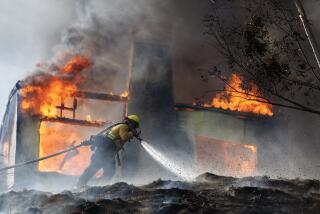Capitol Journal: California’s ‘new normal’ for wildfires is unacceptable
Reporting from Sacramento — Please spare me all the political patter about California burning being the “new normal.” It’s really getting old.
If the new normal means week after week of smoky skies blotching our once-beautiful state, I don’t want to hear about it. Seeing and smelling is depressing enough.
If it means thousands of homes constantly being incinerated and people dying in flames, California is headed into ruins.
Never mind our high taxes, unaffordable housing and regulatory morass, if the new normal is year-round firestorms, sensible people will flee this state. Tourists will vacation where they don’t need to cart fire extinguishers and wear face masks.
I just spent two gloomy weeks at Lake Tahoe. In the old normal, it was gorgeous. This time, you couldn’t see the Sierra Mountains across the lake on most days. Water famed for its spectacular blue color had turned gray, mirroring the sooty sky.
As of Wednesday 14,000 firefighters were battling 15 large wildfires across California, according to the state government. More than 2,000 structures — mostly homes — had been damaged or destroyed.
One hellish fire in Mendocino, Colusa and Lake counties had burned more than 300,000 acres to become the largest California blaze ever recorded — and it was still burning.
Of the 20 largest wildfires in California history, 15 have occurred since 2000. So have 13 of the 20 most destructive fires, measured by structures destroyed. In three Northern California wine country fires last October, 7,774 buildings were wiped out and 31 people killed.
If this is the new normal, the Golden State cannot be sustained.
But the new normal is indeed climate change — hotter weather that, combined with the recent four-year drought, parched vegetation and stoked it for runaway wildfires. But we’re also to blame for failing to clear our forests of dead trees and combustible underbrush. And people and their property become at risk when they dare nature by living in volatile woodlands.
Still, “95% of these fires are started by people,” says Ken Pimlott, director of the California Department of Forestry and Fire Protection, or Cal Fire. “Many times it’s just an accident — a broken down car on the side of a road, someone welding or hitting a rock. One less spark means one less fire. The public has a responsibility here.”
Then there are the creeps who purposely set fires. They should be locked up permanently, especially when the fire kills someone.
The crusade against global warming is noble. But California produces only 1% of the world’s greenhouse gas emissions that are heating the planet. Not every state and nation are as committed to reversing the warming as California. It’ll be a long wait before the cooling commences.
Coverage of California politics »
Meanwhile, we’re in the thick of firestorms. Government’s first duty is to provide public safety. There should be no higher priority for Gov. Jerry Brown and the Legislature than combating wildfires — not homelessness, not healthcare, not water tunnels, not a bullet train.
Brown, who is arguably the country’s most outspoken advocate of combating climate change, has taken some important steps to improve fire prevention and firefighting.
The wildfire threat “would be much worse,” if it weren’t for actions the Brown administration has taken, insists Mark Ghilarducci, director of the state Office of Emergency Services.
How Mendocino Complex became California’s monster fire >>
Brown has started spending $285 million to buy 12 state-of-the-art helicopters that can fly at night and carry more water and fire retardant. They replace old Vietnam-era choppers.
“Cal Fire has the largest aerial firefighting fleet in the world, including 23 state-owned air tankers,” Pimlott says.
Cal Fire is also staffing 52 fire engines all year. It used to staff them only seasonally.
The governor and Legislature have allocated $160 million in cap-and-trade money — derived from selling permits to emit greenhouse gasses — for fire prevention, including thinning forests.
The governor’s budget includes $2.5 billion for Cal Fire. That’s an increase. But to put it in perspective, the total budget is $201 billion.
Brown talks about the “new normal” more than anyone.
“This is part of a trend, a new normal,” he told reporters last week.
“We’ve got to reexamine the way we manage our forests, the way we build our houses, where we build them, how we build them and how much we invest in our fire protection services,” Brown continued. “I don’t like to scare people, but … we’ve got tough times ahead.”
At another Q&A with reporters, the governor warned: “We’re going to have more fire, more destructive fire, more billions that will have to be spent.… All that is the new normal that we have to face.”
OK, so let’s get on with facing it. We need an all-out, no baloney effort.
In the state Legislature there’s a bill by Sen. Hannah-Beth Jackson (D-Santa Barbara) to encourage federal, state and local cooperation on forest management.
“We’ve got 129 million dead trees and we have to figure out how to bring them down,” she says.
Sen. Mike McGuire, a Democrat who represents the charred wine country, has a bill to require a statewide, uniform alert system to warn citizens of roaring wildfires.
“The current system is antiquated, patchworked and clunky,” he says.
“Shame on the Legislature if we don’t pass this legislation. The ‘new normal’ has to be more than just words.”
Any politicians willing to passively accept these devastating wildfires as normal should be replaced with people committed to fighting them as their first priority.
Follow @LATimesSkelton on Twitter
More to Read
Get the L.A. Times Politics newsletter
Deeply reported insights into legislation, politics and policy from Sacramento, Washington and beyond. In your inbox three times per week.
You may occasionally receive promotional content from the Los Angeles Times.











